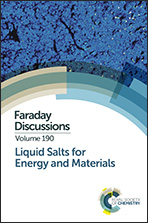Template-free electrodeposition of AlFe alloy nanowires from a room-temperature ionic liquid as an anode material for Li-ion batteries
Abstract
AlFe alloy nanowires were directly electrodeposited on copper substrates from trimethylamine hydrochloride (TMHC)–AlCl3 ionic liquids with small amounts of FeCl3 at room temperature without templates. Coin cells composed of AlFe alloy nanowire electrodes and lithium foils were assembled to characterize the alloy electrochemical properties by galvanostatic charge/discharge tests. Effects of FeCl3 concentration, potential and temperature on the alloy morphology, composition and cyclic performance were examined. Addition of Fe into the alloy changed the nanowires from a ‘hill-like’ bulk morphology to a free-standing morphology, and increased the coverage area of the alloy on Cu substrates. As an inactive element, Fe could also buffer the alloys' large volume changes during Li intercalation and deintercalation. AlFe alloy nanowires composed of a small amount of Fe with an average diameter of 140 nm exhibited an outstanding cyclic performance and delivered a specific capacity of about 570 mA h g−1 after 50 cycles. This advanced template-free method for the direct preparation of high performance nanostructure AlFe alloy anode materials is quite simple and inexpensive, which presents a promising prospect for practical application in Li-ion batteries.
- This article is part of the themed collection: Liquid Salts for Energy and Materials

 Please wait while we load your content...
Please wait while we load your content...